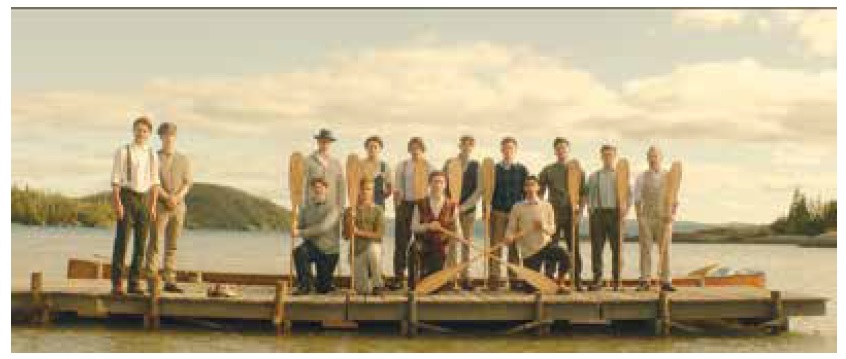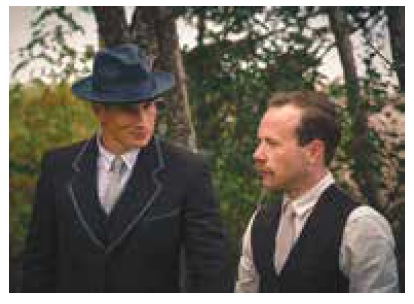
By Gary Kramer–
Gay filmmaker Richard Bell’s handsomely-mounted period piece, Brotherhood, tells the true story of an ill-fated camping trip at Balsam Lake in Canada on July 20, 1926. This modest drama, now available on iTunes and other streaming services, features an all-male cast—a few women appear briefly in flashbacks—and imparts life lessons about leadership, respect, teamwork, and survival.
Robert Butcher (Brendan Fehr) is leading a group of fatherless boys—all members of St. Andrew’s Anglican church—to Long Point Camp. He is met along the way by Arthur Lambden (Brendan Fletcher), who will act as Butcher’s second-in-command. Another teen, George Waller (Jake Manley), arrives separately. The youths are initially defined more by their traits than their names. As such, Leonard (Matthew Isen) sneezes, Will (Sam Ashe Arnold) is the annoying younger brother of Jack (Gage Munroe), and Mark (Mike Taylor) has a glow-in-the-dark watch, etc. The teens’ camaraderie, however, is palpable, especially when they sing together, but also in scenes of them exercising and playing tug-of-war, sitting around a campfire, or goofing around in their tent.
One of the more dramatic moments on land happens during a lacrosse game where Waller loses his temper. Lambden takes the teen for a walk in the woods and insists that Waller chop down a tree. The message the youth learns—both in this scene and in a later episode on the lake—is how to be part of a brotherhood and inspire rather than confront or control. It may be somewhat didactic, but it serves the story well. Likewise, exchanges between Jack and Will nicely emphasize Will’s anxiety—both good and bad—about growing up.

Bell juxtaposes these camping scenes with episodes from the tragedy that befalls the characters: their canoe capsizes during an unexpected storm, stranding the boys and adult men in the moonlit water. Brotherhood cuts back and forth between the camping scenes and the survival-at-sea drama, and this approach dilutes the film of some of its force. Viewers are still learning about the characters as they struggle in the water. Moreover, the actual moment of capsizing is withheld until late in the storytelling, and when it happens, it feels unnecessary.
Nevertheless, the scenes in the lake are artfully filmed, and Bell creates a sense in the open water that alternates between claustrophobia and momentum. Cinematographer Adam Swica shoots the nighttime scenes elegantly, capturing the tactility of the clothes clinging to the bodies, as the boys and men cling to the overturned canoe. (The costumes, designed by Ginger Martini, however, appear too perfect; these boys dressed for camping in what appears to be their Sunday finest. It might be authentic, but perhaps it would have been more appropriate for the kids to look a little less polished.)

The action in the water does form the backbone of Brotherhood, and it is to Bell’s credit that viewers will care about their survival, even if some of the characters are thinly drawn. The director does take pains to flesh out the youth and men with the aforementioned flashbacks depicting the teens and their families, and Arthur and his wife. But these scenes play as filler. The memories could have been related more effectively in dialogue as evidenced by Fletcher’s soulful performance. When Lambden, haunted by survivor’s guilt, recounts losing his wife to the Spanish Flu, it provides an emotional moment.
Brotherhood could have used a few more scenes like this one. Brendan Fehr is respectable as Robert Butcher, a man whose knee injury is the source of greater pain, but he is a bit enigmatic. His discussions with Lambden are compelling—most notably when they talk about building character with risks versus challenges.
In support, Jake Manley is the most prominent of the teens, in part, because his character is defined by his inchoate anger. Manley overdoes his swagger and attitude at first. But once Lambden calms Waller down, the actor nicely adjusts his performance.
It may be that Brotherhood, which recounts a tragedy that is little-known in the United States, is best appreciated by younger viewers who can absorb the messages of heroism, bravery, and sacrifice that are raised as characters start dying. (The film telegraphs some of the deaths, but that is not a flaw.) Likewise, the mentions of religion, the war, and trauma in the film provide some context for the period and the characters without feeling forced.
That said, the repeated fact that Leonard’s father drowned—thereby making him afraid of the water—does feel heavy-handed. The stylized production and appropriately somber music help to convey Bell’s melancholic tone. Brotherhood is unabashedly earnest, but it captures the spirit of its characters, who are resilient in the face of an ordeal.
© 2020 Gary M. Kramer
Gary M. Kramer is the author of “Independent Queer Cinema: Reviews and Interviews,” and the co-editor of “Directory of World Cinema: Argentina.” Follow him on Twitter @garymkramer
Published on July 16, 2020
Recent Comments